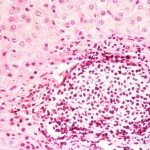Link to Pubmed [PMID] – 16191691
Avian Pathol. 2005 Apr;34(2):111-22
The quasispecies nature of a typical pigeon paramyxovirus type 1 (pPMV-1) was, for the first time, studied under conditions close to the natural infectious environment. The virus was serially passaged in pigeons by successive contacts. Viral heterogeneity was analysed in the kidneys and brain of five pigeons from the last contact, by reverse transcriptase-polymerase chain reactions performed on RNA directly extracted from the organ and targeting the P and HN genes of the virus. The viral diversity following in vivo passage was found to be different from that in the inoculum, but demonstrated the reality of the quasispecies concept for pPMV-1 strains. Moreover, some aberrant genomic RNAs comprising insertions in the P gene editing site or deletions in the HN gene were also detected, with possible consequences for the pathogenicity and infectivity of the virus.

